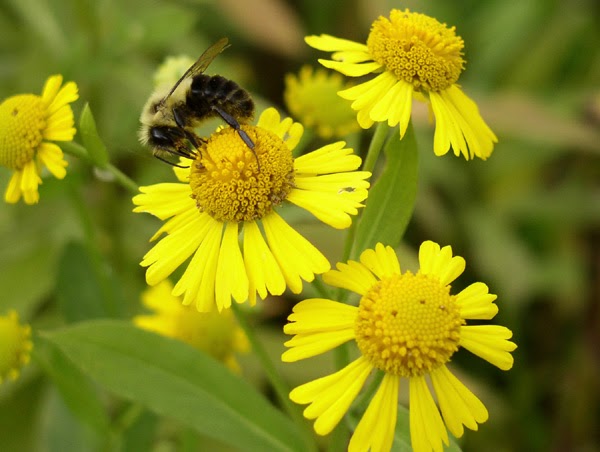 |
| Bumble bee on Helenium © Beatriz Moisset |
Avoid pesticides or if you absolutely need to use them, inform yourself carefully about the specific pesticides that kill only the target species, rather than decimating many others unintentionally. Furthermore, avoiding pesticides may not be as bad as it sounds since nature has its own checks and balances and manages to keep most pests under control without resorting to pesticides. There are some cases in which use of pesticides backfires by destroying these checks and balances. Avoid herbicides also; they can be bad for pollinators. They either deprive them of food or poison them.
 |
| Fritillary on butterfly milkweed © Beatriz Moisset |
 |
| Small bee on fruit tree blossom © Beatriz Moisset |
 |
| Sunflower and bee © Beatriz Moisset |
Plant the kind of lawn that provides habitat beneficial to bees. A perfectly manicured, pesticide saturated lawn is a desert to wildlife, including pollinators. Reducing the size of the lawn would benefit native pollinators. But it is also possible to have a lawn that is good for bees while being esthetically pleasing. As mentioned before, stay away from pesticides and herbicides as much as possible. Second, allow some small wildflowers; the look of your lawn may change as a result but it will continue to serve its purpose. Clover is great food for native bees; it also fixes nitrogen cutting down the need for fertilizers. Other small plants that benefit bees are ground speedwells (Veronica), wood sorrel (Oxalis acetosella), smartweeds or knotweeds (Polygonum), wild strawberries (Fragaria, several species), etc. Rather than calling them weeds we should call them grass companions or pollinator food.
 |
| Nests of solitary bees © Beatriz Moisset |
Provide housing for bees. A simple bare spot here and there (no mulch or grass, just bare soil) may be enough for a few hard-working soil nesters. A sand pile may be even better. It bears repeating: There is no real need to worry about stings from solitary bees.
Dead logs or snags can supply housing for bees. You probably can’t have a dead tree on your property, but it is possible to keep a stump or a standing log and use it as an attractive planter; perhaps it will in turn provide housing for some little bees. Drilling holes on an old post or even a tree trunk would also make good nesting sites. They should be 3/32” to 3/8” in diameter and at least 4” deep.
Or you can make your own bee houses. It is possible and relatively easy to build one by following instructions posted in several websites. Or you can buy one; some resources listed below. I have discovered that watching the comings and goings of those busy mother bees can be as much fun as observing a bird house. Once again, stings don’t seem to be a real problem; I have had my face right in front of their houses and have even let them climb on my finger without any consequences.
Hollow tubes, just about the size of drinking straws, can also be used as bee nests. Some of the suppliers listed sell them. You can also tie up a bunch of hollow twigs, such as elderberry, or paper drinking straws (plastic ones are no good) together or pack them into a container such as a small milk or cream carton and place them horizontally. They should be closed at one end with the open end facing south or southeast. If you have trouble figuring out where the south is, step outside sometime between 10 AM and 1 PM and face the sun. That is how you want to place the nests. (See links below for instructions).
You can let some of your ornamental grasses stay all winter; they can be quite handsome and add variety to your winter landscape while providing nesting to your friendly native bees.
Helping the native bees would benefit us because of their invaluable services to the environment and to our gardens.
 |
| Pollinators and their multiple benefits © Beatriz Moisset |
Resources
Ross, Edward S. (2003) Pollinator Conservation Handbook. The Xerces Society and The Bee Works. Portland, Oregon ISBN 0-9744475-0-1. (Bee gardens, bee houses, etc.)
The Xerces Society Guide (2011). Attracting Native Pollinators. Storey Publishing. ISBN 978-1-60342-695-4 (Everything you want to know about pollinators and their conservation)
Urban Bee Gardens. Berkeley University
Nests for Native Bees. The Xerces Society
Bee houses. National Wildlife Federation. (How to build a bee house)
Sellers of bee houses
Knox Cellars.
Mason bee homes.
List of articles
Beginners Guide to Pollinators and Other Flower Visitors
No comments:
Post a Comment